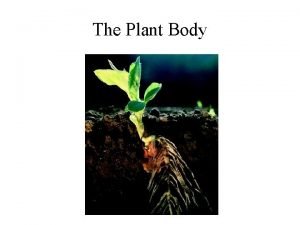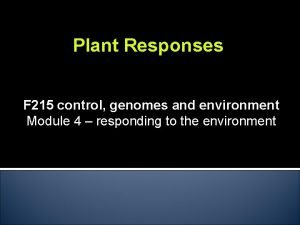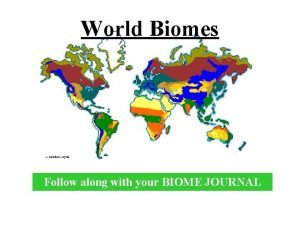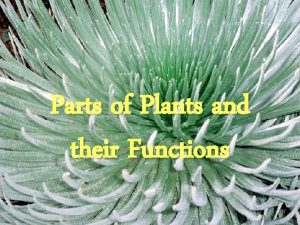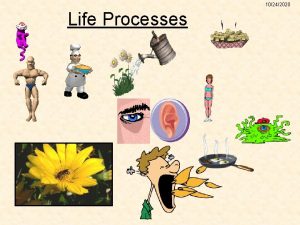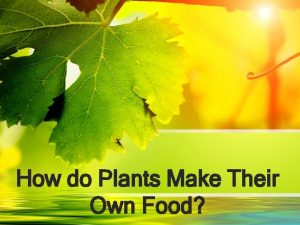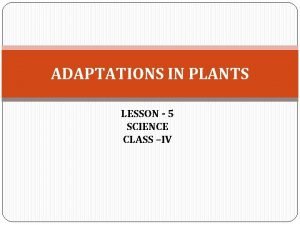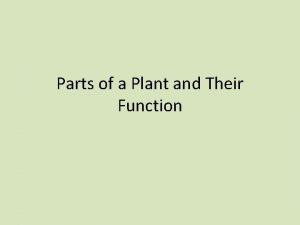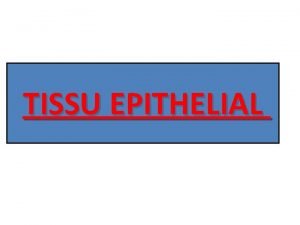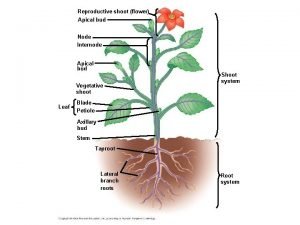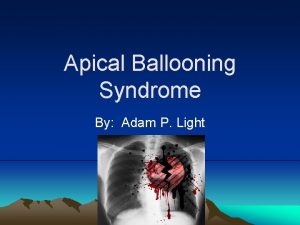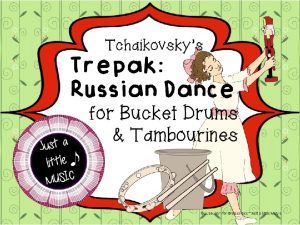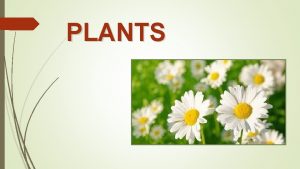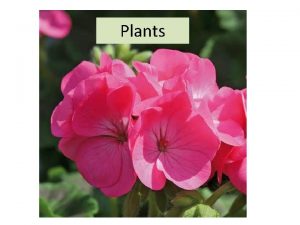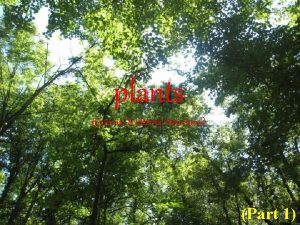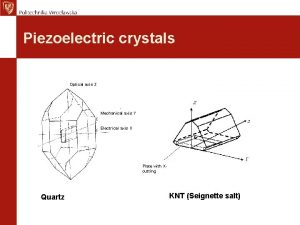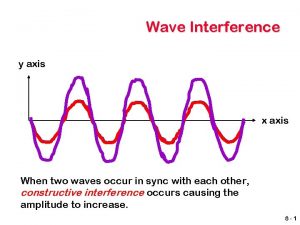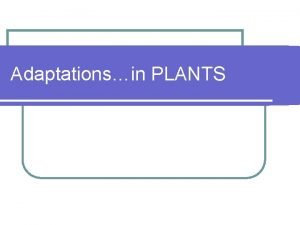Primary growthelongation of plants along their axis apical






















![·If [IAA] = [cytokinin], tissue remains meristematic ·If [IAA] > [cytokinin], tissue develops into ·If [IAA] = [cytokinin], tissue remains meristematic ·If [IAA] > [cytokinin], tissue develops into](https://slidetodoc.com/presentation_image_h2/36dbc1b262a59d9adc6e721c52ca914b/image-23.jpg)














- Slides: 37


Primary growth-elongation of plants along their axis. (apical meristems) Secondary growth- increase in the girth ( lateral meristems)

An irreversible permanent increase in size of an organ or its parts or even of an individual cell

Plant growth is indeterminate because they grow through out their life. Kind of growth wherein new cells are continually added to the plant body by the activity of meristems is called open form of growth or indeterminate growth. Growth can measured by a variety of parameters like - increase in fresh weight, dry weight, length, girth, area, volume, and cell number.

PHASES OF GROWTH - Growth period is divided into three phases meristematic phase, elongation phase & maturation phase. The Zone of Maturation



Arithmetic growth Geometric growth (root elongation) (fruit growth) GROWTH RATE – Increased growth per unit time is termed growth rate.

Absolute Growth Rate (AGR) If you plot growth (size, mass or number) versus time, a constantly increasing growth curve is obtained. If you calculate the slope between any two times, you get the absolute growth rate, which is the change in actual growth over time. You get a different slope, hence different AGR for each pair of times chosen to calculate the slope. Relative Growth Rate (RGR) If you plot the logarithm of growth (size, mass or number) versus time, a linear line is obtained. If you calculate the slope of the line, you get the relative growth rate, which is the change in relative growth over time. Since the line is linear, you get the same RGR, regardless of which time interval chosen to calculate the slope.

Nt = N 0 + rt

Growth of plant body – increase in length Growth in leaf - Increase in surface area

Plant development is the process by which structures originate and mature as a plant grows or all changes that an organism goes through. Plasticity generally means ability to permanently change or deform. (It differs from "elasticity", which refers to ability to change temporarily and revert back to original form. ) Knautia arvensis

cellular differentiation It is the process by which a less specialized cell becomes a more specialized cell type. Dedifferentiation A partially or terminally differentiated cell reverts to an earlier developmental stage. Redifferentiated cells Cells formed from dedifferentiated cells which perform specific function.



GROWTH PROMOTERS AUXINS GROWTH INHIBITORS ABSCISIC ACID GIBBERELLINS CYTOKININS ETHYLENE



Auxins are plant hormones. The most important auxin produced by plants is indole-3 -acetic acid (IAA). Important roles ·development of the embryo & leaf formation ·phototropism ·apical dominance ·promote flowering & fruit development ·prevent fruit & leaf fall but promote abscission in older mature parts. ·root initiation and development 3 -Indole Butyric Acid (IBA)

Synthetic auxins as weed killers Some of the most widely-used weed killers are synthetic auxins. These include 2, 4 -dichlorophenoxy acetic acid (2, 4 -D) and 2, 4, 5 -trichlorophenoxy acetic acid (2, 4, 5 -T). 1 -Naphthalene acetic acid NAA Tissue culture

Plant Hormones - Cytokinins Called "cytokinins" because they stimulate cell division (i. e. , cytokinesis) ·Folke Skoog (1940's) and colleagues at Univ. of Wisconsin found that cultured tobacco pith tissue explants would proliferate only if they were supplemented with various substances such as autoclaved herring sperm or coconut milk. ·Miller (1956) identified the first cytokinin, called kinetin, in the herring sperm. ·Cytokinins occur in most plants including mosses, ferns, conifers, algae and diatoms

Cytokinins ·Stimulates cell division. ·Stimulates morphogenesis (shoot initiation/bud formation) in tissue culture. ·Stimulates the growth of lateral buds-release of apical dominance. ·Stimulates leaf expansion resulting from cell enlargement. ·May enhance stomatal opening in some species. ·Promotes the conversion of etioplasts into chloroplasts via stimulation of chlorophyll synthesis. ·Promote nutrient mobilisation.
![If IAA cytokinin tissue remains meristematic If IAA cytokinin tissue develops into ·If [IAA] = [cytokinin], tissue remains meristematic ·If [IAA] > [cytokinin], tissue develops into](https://slidetodoc.com/presentation_image_h2/36dbc1b262a59d9adc6e721c52ca914b/image-23.jpg)
·If [IAA] = [cytokinin], tissue remains meristematic ·If [IAA] > [cytokinin], tissue develops into a root ·If [IAA] < [cytokinin], tissue develops into a shoot

Bakane (foolish seedling) disease of rice seedlings 1926 - E. Kurosawa - studied a parasitic fungus (Gibberella fujikuroi) which was found to produce a substance which caused plants to "bolt" (to develop weak, abnormally elongated stems). It was found that the fungus caused an abnormal concentration of a substance later named "gibberellin" (after the fungus) to be produced in the bolting stems.

The gibberellins are named GA 1. . GAn in order of discovery. Gibberellic acid, which was the first gibberellin to be structurally characterised , is GA 3. There are currently 136 GAs identified from plants, fungi and bacteria. Functions Promote stem elongation, Increase fruit size (often applied synthetically to make fruit more marketable) Activate digestive enzymes in embryos, to mobilize stored nutrients in the endosperm and initiate metabolism Involved in PARTHENOCARPIC fruit production & Stimulate flowering (auxin does this, too). Can delay senescence in leaves and citrus fruits.

This is what you don't want to happen to flowering cabbage and kale. When temperatures are too warm, the plants bolt and go to flower. The stretched out plants are not nearly as attractive then as when they retain their low, compact symetrical habit

Ethylene H 2 C=CH 2 ·Stimulates the release of dormancy. ·Stimulates shoot and root growth and differentiation (triple response) ·May have a role in adventitious root formation. ·Stimulates leaf and fruit abscission. . ·Induction of femaleness in dioecious flowers. ·Stimulates flower opening. ·Stimulates flower and leaf senescence. ·Stimulates fruit ripening.

Abscisic acid (ABA), is also known as abscisin II and dormin, History of Abscisic Acid In 1963, abscisic acid was first identified and characterized by Frederick Addicott and his associates. They were studying compounds responsible for the abscission of fruits (cotton). Two compounds were isolated and called abscisin I and abscisin II. Abscisin II is presently called abscisic acid (ABA) (Addicot, 1963). Two other groups at about the same time discovered the same compound. One group headed by Philip Wareing was studying bud dormancy in woody plants. The other group led by Van Steveninck was studying abscission of flowers and fruits from lupine. Plant physiologists agreed to call the compound abscisic acid (Salisbury and Ross, 1992).

Functions of Abscisic Acid ABA is also called stress hormone ·Stimulates the closure of stomata (water stress brings about an increase in ABA synthesis). ·Inhibits shoot growth but will not have as much affect on roots or may even promote growth of roots. ·Induces seeds to synthesize storage proteins. ·Inhibits the affect of gibberellins. ·Has some effect on induction and maintanance of dormancy.

photoperiodism The ability of certain plants to sense the relative amounts of light and dark in a 24 -hour period; controls the onset of flowering in many plants. Spinach Chrysanthemum


Short day plants (SDP) They flower when the day length is less than a certain critical length say 12 hrs. If these plants are exposed to day lengths in excess of this critical point, they continue growing vegetatively. Examples: Nicotiana tabacum, soyabean, strawberry, oryza sativa, sugarcane, cosmos and chrysanthemum. Long Day Plants (LDP) Long day plants flower when the day length is greater than a certain critical length, say twelve hours. Examples: Pisum sativum, Triticum aestivum, Onion, hibiscus, turnip, lettuce, carrot and spinach. Day Neutral Plants These plants flower in all possible photoperiods, ranging from a few hours to 24 hours of uninterrupted light exposure. They are also called photo neutrals or intermediate plants. Examples: Tomatoes, cucumbers, sunflower, rose, dandelions and cotton.

Florigen or Flowering hormone are the terms used for the hypothesized hormone-like molecules that control and/or trigger flowering in plants. The current "Flowering Hormone" is still a mystery. Experiments suggest that florigen does exist. The substance that triggers blooming is produced or activated in the leaves of the plant, and must be given time to pass out of the leaves before the plant can flower.

Vernalisation - acceleration of plant development by exposing seeds or bulbs to cold temperatures. Arabidopsis thaliana

Ethylene has been used in practice since the ancient Egyptians, who would gas figs in order to stimulate ripening. The ancient Chinese would burn incense in closed rooms to enhance the ripening of pears. It was in 1864, that leaks of gas from street lights showed stunting of growth, twisting of plants, and abnormal thickening of stems (the triple response)(Arteca, 1996; Salisbury and Ross, 1992). In 1901, a russian scientist named Dimitry Neljubow showed that the active component was ethylene (Neljubow, 1901). Doubt discovered that ethylene stimulated abscission in 1917 (Doubt, 1917). It wasn't until 1934 that Gane reported that plants synthesize ethylene (Gane, 1934). In 1935, Crocker proposed that ethylene was the plant hormone responsible for fruit ripening as well as inhibition of vegetative tissues


Imaging of chlorophyll autofluorescence by confocal microscopy in intact whole petals of Arabidopsis thaliana has been used to analyze chloroplast development and redifferentiation during petal development. Young petals dissected from unopened buds contained green chloroplasts throughout their structure, but as the upper part of the petal lamina developed and expanded, plastids lost their chlorophyll and redifferentiated into leukoplasts, resulting in a white petal blade.
 Apical long axis view
Apical long axis view Apical dominance
Apical dominance Apical dominance
Apical dominance Three point charges are arranged along the x-axis
Three point charges are arranged along the x-axis A pitcher tosses a baseball up along y axis
A pitcher tosses a baseball up along y axis Direct axis and quadrature axis
Direct axis and quadrature axis Direct axis and quadrature axis
Direct axis and quadrature axis Axis 1 and axis 2 disorders
Axis 1 and axis 2 disorders Transverse axis hyperbola
Transverse axis hyperbola Transverse axis vs conjugate axis
Transverse axis vs conjugate axis Axis 1 and axis 2 disorders
Axis 1 and axis 2 disorders Fern is vascular or nonvascular
Fern is vascular or nonvascular Non vascular vs vascular plants
Non vascular vs vascular plants Features of non flowering plants
Features of non flowering plants C3 plant
C3 plant Vertical display adalah
Vertical display adalah Savanna animals adaptations
Savanna animals adaptations General objectives of plants
General objectives of plants Seven life processes
Seven life processes Photosynthesis glossary
Photosynthesis glossary Parts of the plants and function
Parts of the plants and function Green plants make their own food by photosynthesis
Green plants make their own food by photosynthesis How indoor plants make their food
How indoor plants make their food Adaptation in plants class 7
Adaptation in plants class 7 4 parts of plants
4 parts of plants Pith
Pith Primary growth and secondary growth in plants
Primary growth and secondary growth in plants Primary growth and secondary growth in plants
Primary growth and secondary growth in plants Normal ranges for children's vitals
Normal ranges for children's vitals Apical pulse location
Apical pulse location Location of apical pulse
Location of apical pulse Vital signs normal range
Vital signs normal range Cephalic vein
Cephalic vein Triple antibiotic paste uses
Triple antibiotic paste uses Stériocils
Stériocils Normal adult vital signs
Normal adult vital signs Reproductive shoot (flower)
Reproductive shoot (flower) Where is the apical pulse located
Where is the apical pulse located

